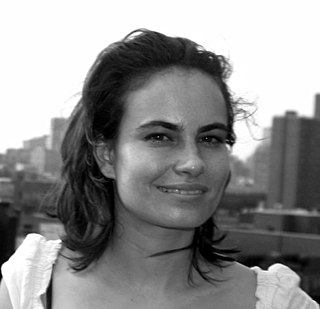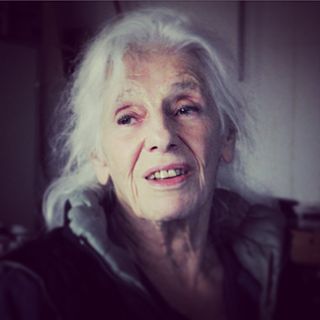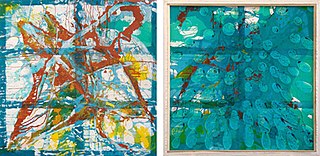Related Research Articles

Agnes Bernice Martin was an American abstract painter known for her minimalist style and abstract expressionism. Born in Canada, she moved to the United States in 1931, where she pursued higher education and eventually became a U.S. citizen in 1950. Martin's artistic journey began in New York City, where she immersed herself in modern art and developed a deep interest in abstraction. Despite often being labeled a minimalist, she identified more with abstract expressionism. Her work has been defined as an "essay in discretion on inward-ness and silence".

The Buffalo AKG Art Museum, formerly known as the Albright–Knox Art Gallery, is an art museum in Buffalo, New York, United States, in Delaware Park. The museum was expanded beginning in 2021, and re-opened in June 2023.

Inka Essenhigh is an American painter based in New York City. Throughout her career, Essenhigh has had solo exhibitions at galleries such as Deitch Projects, Mary Boone Gallery, 303 Gallery, Stefan Stux Gallery, and Jacob Lewis Gallery in New York, Kotaro Nukaga, Tomio Koyama Gallery in Tokyo, and Il Capricorno in Venice.

Harry Lee Gatch was a twentieth-century American artist known for his lyrical abstractions and his ability to find "a fresh approach" to painting the figure and nature "through interwoven patterns of flattened figures" and a Fauvist-inspired sense of landscape.
Friedel Dzubas was a German-born American abstract painter.

Josephine Gail Baer is an American painter associated with minimalist art. She began exhibiting her work at the Fischbach Gallery, New York, and other venues for contemporary art in the mid-1960s. In the mid-1970s, she turned away from non-objective painting. Since then, Baer has fused images, symbols, words, and phrases in a non-narrative manner, a mode of expression she once termed "radical figuration." She lives and works in Amsterdam, Netherlands.

Kenzo Okada was a Japanese-born American painter and the first Japanese-American artist working in the Abstract Expressionist style to receive international acclaim. At the 29th Venice Biennale in 1958, Okada’s work was exhibited in the Japan Pavilion and he won the Astorre Meyer Prize and UNESCO Prize.
Peter Ford Young is an American painter. He is primarily known for his abstract paintings that have been widely exhibited in the United States and in Europe since the 1960s. His work is associated with Minimal Art, Post-minimalism, and Lyrical Abstraction. Young has participated in more than a hundred group exhibitions and he has had more than forty solo exhibitions in important contemporary art galleries throughout his career. He currently lives in Bisbee, Arizona.

Chryssa Vardea-Mavromichali was a Greek American artist who worked in a wide variety of media. An American art pioneer in light art and luminist sculpture, known for her neon, steel, aluminum and acrylic glass installations, she always used the mononym Chryssa professionally. She worked from the mid-1950s in New York City studios and worked since 1992 in the studio she established in Neos Kosmos, Athens, Greece.

Paul Feeley was an artist and director of the Art Department at Bennington College during the 1950s and early 1960s.
Ed Moses was an American artist based in Los Angeles and a central figure of postwar West Coast art.

Deborah Remington was an American abstract painter. Her most notable work is characterized as Hard-edge painting abstraction.

Polly E. Apfelbaum is an American contemporary visual artist, who is primarily known for her colorful drawings, sculptures, and fabric floor pieces, which she refers to as "fallen paintings". She currently lives and works in New York City, New York.
John Millard Ferren was an American artist and educator. He was active from 1920 until 1970 in San Francisco, Paris and New York City.

Dona Nelson is an American painter, best known for immersive, gestural, primarily abstract works employing unorthodox materials, processes and formats to disrupt conventional notions of painting and viewership. A 2014 New Yorker review observed, "Nelson gives notice that she will do anything, short of burning down her house to bully painting into freshly spluttering eloquence." Since 2002, long before it became a more common practice, Nelson has produced free-standing, double-sided paintings that create a more complex, conscious viewing experience. According to New York Times critic Roberta Smith, Nelson has dodged the burden of a "superficially consistent style," sustained by "an adventuresome emphasis on materials" and an athletic approach to process that builds on the work of Jackson Pollock. Writers in Art in America and Artforum credit her experimentation with influencing a younger generation of painters exploring unconventional techniques with renewed interest. Discussing one of Nelson's visceral, process-driven works, curator Klaus Kertess wrote, the paint-soaked "muslin is at once the tool, the medium, and the made."
Erin Shirreff is a Canadian artist who works primarily in photography, sculpture, and video.
Sigrid Sandström is a Swedish artist and a professor of Painting at the Academy of Fine Arts in Helsinki. Her work is characterized by graphic abstraction, an embrace of color and difference in scale, and an array of techniques used to apply paint and other materials to canvas, ranging from cloths and rugs, to masking with tape, squeegee-ing and smearing, and collaging. She has also worked in film and video, most notably for her 2005 exhibition Her Black Flags at the Mills College Art Museum in Oakland, CA, and in sculpture and installation. Artforum critic Naomi Fry, reviewing a 2007 show at Edward Thorp Gallery, cited the artist's interest in landscape as subject and noted that Sandström "also grapples here with painting’s essential difficulty in the face of the sublime. As the works consistently teeter on the verge of abstraction, the interplay between a more traditional naturalism and geometric fragmentation provides a salient tension."
Ann Pibal is an American painter who makes geometric compositions using acrylic paint on aluminum panel. The geometric intensity is one of the key characteristics that defines her paintings.
Frances Barth is an American visual artist best known for paintings situated between abstraction, landscape and mapping, and in her later career, video and narrative works. She emerged during a period in which contemporary painters sought a way forward beyond 1960s minimalism and conceptualism, producing work that combined modernist formalism, geometric abstraction, referential elements and metaphor. Critic Karen Wilkin wrote, "Barth’s paintings play a variety of spatial languages against each other, from aerial views that suggest mapping, to suggestions of perspectival space, to relentless flatness … [she] questions the very pictorial conventions she deploys, creating ambiguous imagery and equally ambiguous space that seems to shift as we look."

Andrew Spence is an American artist known for abstract paintings that combine a minimalist vocabulary with playful references to the observed world. In the 1970s and 1980s, he gained recognition as one of a number of younger artists who were re-examining geometric modernism through a contemporary lens that invited humor and reference to everyday objects and life experience into the tradition. Spence's method of distilling visual phenomena into simple, emblematic images has been compared to Ellsworth Kelly, but his work has differed in its more even balance between abstraction and recognition, intuitive approach, and varied, expressive paint surfaces. Art in America critic Ken Johnson wrote that his work maintains "an ironic tension between lofty purism of modernist geometry and earth-bound ordinariness of the vernacular sources." In later paintings, Spence has increasingly obscured the original inspirations of his abstractions, in both form and titling. His work belongs to the permanent collections of the Metropolitan Museum of Art, Museum of Modern Art, and Whitney Museum of American Art, among others. He has received a Guggenheim Fellowship and awards from the American Academy of Arts and Letters and National Endowment for the Arts.
References
- 1 2 "Karin Davie". Smithsonian American Art Museum. Retrieved September 13, 2021.
- ↑ "Karin Davie". John Simon Guggenheim Foundation. Retrieved September 13, 2021.
- ↑ Johnson, Ken (November 22, 2002). "Art in Review: Karin Davie". The New York Times. Retrieved June 12, 2013.
- ↑ Allen, Jan (2009). Karin Davie: Underworlds. Kingston, Ontario, Canada: Agnes Etherington Art Centre Publications / ABC Art Books, Canada. ISBN 978-1553390954.
- ↑ Graves, Jen. "Spooning and Dripping: The Bodily Grandeur of Karin Davie". The Stranger, Index Newspapers, LLC. Retrieved June 12, 2013.
- ↑ Davie, Karin. "Aldrich Contemporary Art Museum Interview with Karin Davie". Karin Davie. Retrieved June 3, 2013.
- ↑ "Karin Davie: Dangerous Curves". Albright-Knox. Retrieved September 13, 2021.
- ↑ "Karin Davie". Albright-Knox. Retrieved September 13, 2021.
- ↑ "Works – Karin Davie". Seattle Art Museum. Retrieved September 13, 2021.
- ↑ "View 2". Nerman Museum. Johnson County Community College. Retrieved September 13, 2021.